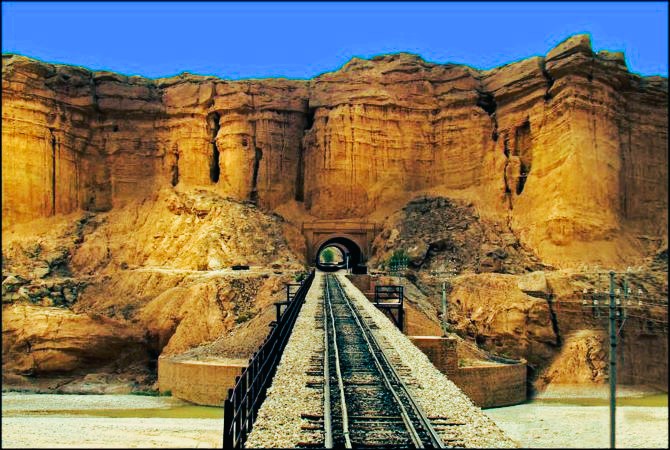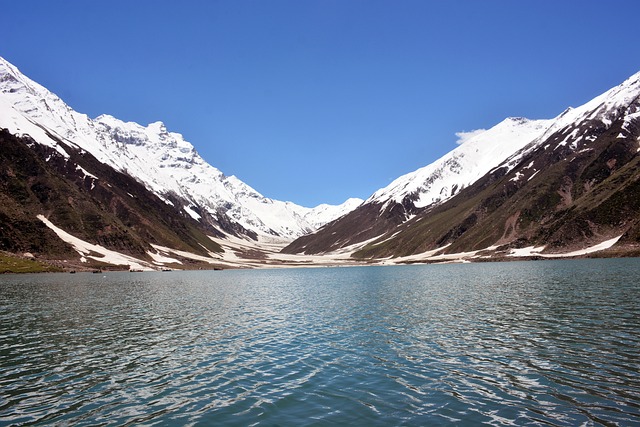The Rohri to Quetta Railway Track: An Informative Journey Through Pakistan in 2025
The Rohri to Quetta railway track is a major railway line in Pakistan. It connects Rohri in Sindh to Quetta in Balochistan. The track is 865 kilometres long.

History of the Track
The track was built in 1879. It was constructed by the British. The track played a crucial role in the development of Pakistan.
Route and Stations
The track passes through several major cities. These cities include Sukkur, Jacobabad, and Sibi. The track has 44 stations.
Scenic Beauty
The track passes through beautiful landscapes. It passes through the Khyber Pass and the Bolan Pass. The track also passes through the Sulaiman Mountains.
Importance of the Track
The track is important for Pakistan’s economy. It transports goods and people. The track also promotes tourism.
Challenges and Future Plans
The track faces several challenges. These challenges include old infrastructure and lack of maintenance. Plans are underway to upgrade the track.
Highlights of the Rohri to Quetta Railway Track Journey
The Rohri to Quetta railway track is a significant route in Pakistan, offering a unique blend of natural beauty, cultural experiences, and historical landmarks. Here are the key highlights of this journey:
- Scenic Landscapes: The train passes through diverse landscapes, including deserts, mountains, and valleys. The changing scenery provides a captivating visual experience.
- Historical Stations: The route includes historic stations like Rohri, Sukkur, and Quetta, each with its own architectural and cultural significance.
- Bolan Pass: The train traverses the Bolan Pass, a strategic and scenic mountain pass that connects the southern plains to the highlands of Balochistan.
- Tunnel Experiences: The journey includes passing through tunnels, offering a unique experience and breathtaking views as the train emerges from these tunnels.
- Cultural Experiences: Passengers can observe and experience the diverse cultures of Sindh and Balochistan, including local food, music, and handicrafts.
- Wildlife and Nature: The route passes through areas known for their wildlife, such as the Sulaiman Mountains, offering glimpses of indigenous species.
- Quetta City: The journey culminates in Quetta, a city known for its natural beauty, historical sites, and vibrant markets, providing ample opportunities for exploration.
This journey on the Rohri to Quetta railway track is a comprehensive experience, combining natural beauty, cultural richness, and historical significance, making it a memorable adventure for travellers.
Tunnel on the Rohri to Quetta Railway Track
The Rohri to Quetta railway track passes through a significant tunnel. Bolan Pass (Urdu: درۂ بولان) is a valley and a natural gateway[2] through the Toba Kakar range[citation needed] in Balochistan province of Pakistan. It is situated 120 km (75 miles) south of Pakistan’s border with Afghanistan. The pass is an 89 km (55 miles) stretch of the Bolan River valley from Rindli in the south to Darwāza near Kolpur in the north. It is made up of several narrow gorges and stretches.[2] It connects Quetta with Sibi by road and railway.
Key Features of the Tunnel:
- Location: The tunnel is situated in the Bolan Pass
- Length: The tunnel is approximately 4 kilometres long.
- Construction: The tunnel was constructed by British engineers in the late 19th century.
- Geological Challenges: The tunnel passes through hard rock formations, making its construction a remarkable feat.
- Engineering Marvel: The tunnel is an engineering marvel of its time, considering the limited technology and resources available during its construction.
- tunnels, bridges, and culverts to overcome the difficult terrain.
The Rohri to Quetta Railway Track: A Marvel of Engineering
Despite the challenges, the Rohri to Quetta railway track is an engineering marvel that has been successfully operating for decades. Its construction required innovative solutions and careful planning to overcome the obstacles posed by the rugged terrain.
The Rohri to Quetta railway track is a remarkable feat of engineering that spans across the rugged terrain of Pakistan. One of its most notable features is that it boasts the longest railway gradient in the world.
What is a Railway Gradient?
A railway gradient refers to the slope or incline of a railway track. It is a measure of how steep the track is, usually expressed as a percentage or a ratio. The steeper the gradient, the more challenging it is to construct and maintain the track.
The Rohri to Quetta Railway Track’s Gradient
The Rohri to Quetta railway track has a gradient of 1 in 25, which means that for every 25 meters of horizontal distance, the track rises by 1 meter. This may not seem like a lot, but it is a significant incline that requires careful engineering and construction to ensure safe and efficient train travel.
Challenges of the Gradient
The long gradient on the Rohri to Quetta railway track poses several challenges, including:
- Increased energy consumption: Trains need to work harder to climb the incline, which increases energy consumption and reduces efficiency.
- Reduced speed: Trains need to slow down to navigate the steep incline, which reduces travel time and increases the risk of accidents.
- Increased maintenance: The steep gradient puts additional stress on the track and trains, which requires more frequent maintenance and repairs.
- Scenic Views: The tunnel offers breathtaking views of the surrounding landscape, with cliffs and rugged terrain on both sides.
- Strategic Importance: The tunnel plays a crucial role in connecting the Sindh and Balochistan provinces, facilitating the transportation of goods and people.
- Maintenance and Upkeep: The tunnel requires regular maintenance and upkeep to ensure safe and smooth train operations.
- Tourist Attraction: The tunnel has become a popular tourist attraction, with many visitors eager to experience the thrill of passing through it.
- Historical Significance: The tunnel holds significant historical value, serving as a testament to the ingenuity and perseverance of the engineers who built it.
- Construction Time:
The Rohri to Quetta Railway Track was completed in 1886. The construction of the track took around 6 years to complete, from 1880 to 1886. - Total Length:
The total length of the track is approximately 592 kilometres (368 miles). - Challenges:
The construction of the track was a challenging task due to the difficult terrain and harsh weather conditions. The track passes through the Sulaiman Mountains and the Bolan Pass, which makes the construction process even more complex. - Engineering Feat:
The completion of the Rohri to Quetta Railway Track was a significant engineering feat at that time. It required the construction of numerous Journey Through Bolan Pass
The Bolan Pass is a mountain pass in western Pakistan that connects the cities of Quetta and Sibi. The Rohri to Quetta railway track passes through this scenic pass, offering breathtaking views of the surrounding mountains and valleys.
Key Features of the Journey
- The Bolan Pass is 7200 feet above sea level.
- The pass is 6,800 feet (2,100 m) above sea level.
- The railway track winds its way through the pass, offering stunning views of the surrounding landscape.
- The journey takes approximately 6-8 hours to complete, depending on the type of train and the number of stops along the way.
Scenic Views
- The Bolan Pass offers breathtaking views of the surrounding mountains and valleys.
- The pass is surrounded by rugged hills and mountains, with cliffs and deep valleys.
- The scenery changes dramatically as the train passes through the pass, with the landscape shifting from arid desert to lush green valleys.
Tips for Tourists
- The best time to visit the Bolan Pass is from March to October when the weather is mild and pleasant.
- Tourists should bring warm clothing, as the temperature can drop significantly at night.
- The pass is a remote area, and tourists should be prepared for limited amenities and services.
- The journey can be tiring, and tourists should bring food, water, and other essentials to sustain themselves during the trip.
Railway Stations Along the Way
- The main railway stations along the way are Quetta, Sibi, and Rohri.
- These stations offer basic amenities, including food, water, and restrooms.
- Tourists can also get off at smaller stations along the way to explore the surrounding countryside.
Overall, the journey through the Bolan Pass is a unique and unforgettable experience that offers breathtaking views and a glimpse into the rugged beauty of Pakistan’s landscape.
Planning a Visit to the Rohri to Quetta Railway Track
To plan a visit to the Rohri to Quetta railway track, follow these steps:
- Check the Train Schedule: Look up the schedule for the train that runs on this track. The Pakistan Railways website or mobile app can provide this information.
- Book Your Tickets: Book your tickets in advance to ensure availability. You can book tickets online or at the railway station.
- Choose Your Class: Pakistan Railways offers different classes of travel, including Economy, AC Business, and AC Sleeper. Choose the class that suits your budget and preferences.
- Pack Accordingly: The journey takes you through different climates and landscapes. Pack clothes and essentials accordingly.
- Plan Your Itinerary: Decide how much time you want to spend at each station or stop. Plan your itinerary to make the most of your journey.
- Respect Local Culture: Be respectful of local culture and traditions. Dress modestly and follow local customs.
- Stay Safe: Follow safety guidelines and instructions from railway staff. Keep your belongings secure and be aware of your surroundings.
- Enjoy the Scenery: The Rohri to Quetta railway track passes through stunning landscapes. Enjoy the scenery and take plenty of photos.
Tips for Tourists
- Bring a Camera: The scenery is breathtaking, so don’t forget your camera.
- Stay Hydrated: Bring plenty of water and snacks to stay hydrated and energized throughout the journey.
- Be Prepared for Delays: Delays can happen, so be prepared and patient.
- Respect the Environment: Take your trash with you and respect the environment.
By following these steps and tips, you can plan a memorable and enjoyable visit to the Rohri to Quetta railway track.
Conclusion
The Rohri to Quetta railway track’s status as the longest railway gradient in the world is a testament to the ingenuity and skill of the engineers who designed and built it. While it poses significant challenges, the track remains an important transportation artery for Pakistan, connecting the country’s major cities and facilitating trade and commerce.
The Rohri to Quetta railway track is a vital part of Pakistan’s transportation network. It connects major cities and promotes economic growth. The track is also a popular tourist destination.
Exploring the Cold Desert of Skardu 2024: A Hidden Gem in Northern Pakistan
